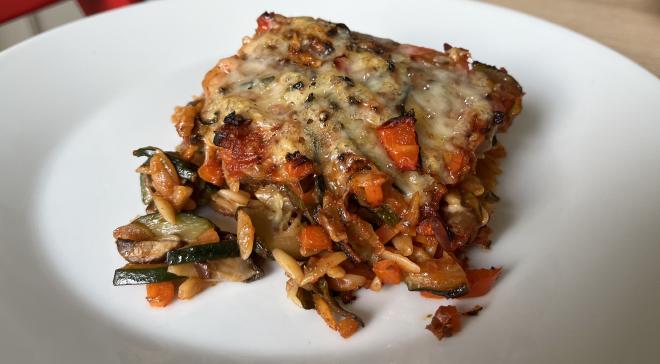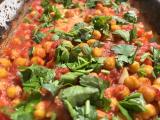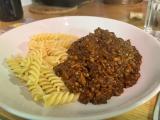Vegetarian Giouvetsi
Table of Contents
Jump to Recipe
Jump to Carbon Footprint
Giouvetsi is a classic Greek oven dish that is prepared with rice noodles (kritharaki) and traditionally braised lamb or beef. Here you will find a vegetarian version with lots of vegetables - if you leave out or replace the grated cheese, the dish even becomes vegan.

The term “giouvetsi” actually stands for a clay pot, but the dish also works wonderfully in a conventional casserole dish. The rice noodles soak up the sauce during baking and taste simply wonderful.
Of course, you can also vary the vegetables and use other Mediterranean vegetables. The same goes for the herbs: I use thyme and smoked paprika here, but of course, you can also use oregano, rosemary, and other Mediterranean herbs in addition or instead, depending on your personal taste. It will be especially great if you have fresh herbs that you add to each portion when serving after baking.
The recipe here is based on the great German blog Zitronen & Olivenöl (Lemons & Olive Oil) with lots of delicious Greek recipes.

Recipe #
Vegetarian giouvetsi
40 minutes
2 portions
Ingredients #
- 1 small red onion
- 1 clove garlic
- 1/2 zucchini (approx. 100g)
- 1 carrot
- 1 pointed bell pepper
- 1 spring onion
- 100 g mushrooms
- 125 g kritharaki / orzo noodles / rice noodles
- 4 teaspoons olive oil
- 1 tablespoon tomato paste
- 1 teaspoon thyme
- 150 g strained tomatoes
- 100+100 ml water
- 1 pinch salt
- 1 pinch pepper
- 1/2 teaspoon smoked paprika
- about 75 g grated cheese for gratinating
Directions #
- Peel and finely dice the onion and garlic. Wash the remaining vegetables (zucchini, carrot, bell pepper, spring onion, mushrooms), peel if necessary, and also cut into cubes or slices.
- Heat about 1 teaspoon of olive oil in a pan and fry the kritharaki for about a minute. (This prevents them from sticking together later).
- Place the kritharaki in an ovenproof dish. Heat another teaspoon of olive oil and sauté the zucchini and mushrooms for a few minutes, then add to the baking dish.
- Preheat the oven to 200°C fan oven.
- Add the remaining olive oil to the pan and fry the onion, garlic, carrot, bell pepper, and spring onion for about 4-5 minutes. Then add the thyme and tomato paste, stir well and fry for a further 2 minutes. Then add the strained tomatoes and about 100 ml water and simmer for about 5-7 minutes.
- Then transfer the mixture to the rice noodles and vegetables in the casserole dish. Stir everything well, season with salt, pepper, and paprika powder. Everything should be well covered with liquid - add a little more water if necessary.
- Bake for about 20-25 minutes on the middle shelf of the preheated oven. Remove from the oven about 8 minutes before the end and sprinkle with grated cheese, then continue baking.
Carbon Footprint #
In total, two portions of vegetarian giouvetsi have an estimated carbon footprint of 1426 g.
This ranks it number 26 out of 57 recipes published on the blog so far in terms of estimated carbon footprint.
The estimated emissions are therefore still slightly better than the average of the recipes.When it comes to the individual ingredients, the cheese and the various vegetables are particularly noticeable: We actually only sprinkle a layer of cheese on top at the end, but this immediately causes more than 30% of the climate impact of this recipe (compared to 7% of the ingredient weight due to cheese). The opposite is true for vegetables: Onion, zucchini, carrot, and pointed bell pepper together account for 35% of the ingredient weight, but their combined carbon footprint is only about 10% of the giouvetsi’s total footprint.
| ingredient | carbon footprint per kg | carbon footprint (in g) for 2 servings | % of ingredients | % of CO2 emissions |
|---|---|---|---|---|
| Onion | 0.2 | 10 | 4% | 1% |
| Garlic | 0.5 | 1 | 0% | 0% |
| Zucchini | 0.2 | 20 | 9% | 1% |
| Carrot | 0.1 | 8 | 7% | 1% |
| Bell pepper | 0.6 | 96 | 14% | 7% |
| Spring onion | 0.7 | 14 | 2% | 1% |
| Mushrooms | 1.3 | 130 | 9% | 9% |
| Kritharaki | 0.7 | 88 | 11% | 6% |
| Olive oil | 3.2 | 80 | 2% | 6% |
| Tomato paste | 4.3 | 52 | 1% | 4% |
| Thyme | 1.1 | 7 | 1% | 0% |
| Strained tomatoes | 1.8 | 270 | 13% | 19% |
| Water | 0.0 | 0 | 18% | 0% |
| Salt | 0.7 | 1 | 0% | 0% |
| Pepper | 1.4 | 1 | 0% | 0% |
| Paprika powder | 1.1 | 3 | 0% | 0% |
| Grated cheese | 6.0 | 450 | 7% | 32% |
| Fry vegetables | 47 | 3% | ||
| Bake casserole | 149 | 10% |


